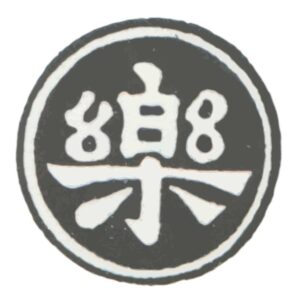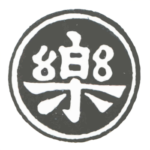
Gyato-yaki is a type of pottery produced in Kyoto. A type of pottery with a low degree of fire that results from the fabrication of finger-heads. It is said to have been founded in the Azuchi-Momoyama period by a naturalized Japanese citizen named Ameya (飴也・屋). The name Raku ware is said to have originated from the pottery produced by Chojiro I in the Juraku Palace of Hideyoshi Toyotomi, which was initially called Juraku ware, and was later called Raku ware when Tsunekei II was given a seal with the Raku character and began to use it. The main products are tea bowls, but there are also tea caddies, incense burners, water jars, incense containers, etc. The tea bowls include Akaraku, Kuroraku, and Kurokurokuroku. The early Akaraku ware was made of polychrome clay, while the Kuro-ragaku ware was made of Makuro-ishi, a glaze produced in the upper reaches of the Kamo River. There is also a white glaze called koro glaze, but its use is rare. Raku ware is a unique product that emerged in response to the demands of the tea ceremony in Japan, and all of its characteristics are in line with the spirit of the tea ceremony. It has a quality suitable for maintaining the warmth of tea, a stable and irregular shape, and a graceful and tranquil taste that can only be achieved by hand-kneading, such as the skillful use of the “gogaku” (five peaks) technique and the subtle hues of the colors. It is said that Chojiro probably created this uniquely Japanese tea bowl under the guidance of Sen no Rikyu.
Raku ware has been handed down from generation to generation by the Raku family of Kyoto, and according to the “Raku ware Iemoto” (Raku ware Iemoto), the original master, Aumeya Sokei (according to recent documents, Sokei was a different person with the surname Tanaka), was naturalized in Japan in the Eisho period (1504-21). His age is unknown, but various documents state that he died in 1574 (Tensho 2) at the age of 82. Wife of Ameya, daughter of the Sasaki family. The year of her death and the year of her death are unknown. He was first named Chojiro, then Sasaki, and later Tanaka (according to his family’s data, his wife’s family was Tanaka). Died on September 7, 1592 (according to the “Rakuke Souiri Bunsho,” he died in 1589, the 17th year of Tensho), age unknown. The second Tsunekei, whose childhood name was Yozugi and Kichizaemon, was called Sokei and later Tsunekei. Died on May 29, 1635 at the age of 75. He was the third Michiru. Died on February 23, 1656 at the age of 58. Ichiiri IV, first named Sahei, later Kichizaemon, shaved his hair and assumed the name Ichito, died on January 29, 1696 (Genroku 9), aged 57. The fifth Muneiri, whose name was Sokichi at the beginning and later Kichizaemon, shaved his head and took the name Muneiri, died on September 3, 1716, at the age of 53. The sixth Souiri was named Sokichi at first, then Kichizaemon, and after shaving his head he became Souiri; he died on September 25, 1739 at the age of 55. The seventh generation Chouiri was named Sokichi at first, later Kichizaemon, then shaved his head and assumed the name of Chouiri; he died on September 5, 1770, aged 57. He died on September 5, 1770, at the age of 57. He died on November 10, 1774 at the age of 30. He died on November 10, 1774, aged 30. He died on September 17, 1834 at the age of 79. He died on September 17, 1834, at the age of 79. He died on November 24, 1854 at the age of 60. The eleventh Keiryu was Sokichi for the first time, and later Kichizaemon. He died on January 3, 1902 at the age of 86. The twelfth Kouri at first Kozaburo, later Sojiro and Kichizaemon. He died on September 24, 1932 at the age of 76. He was the thirteenth Soyiri Hajime Sokichi, and later Kichizaemon. He died on March 8, 1944 at the age of 58.
The works of generations of the Raku family are called the main kiln of Raku ware, while those of family members or disciples are called the side kilns. The Raku family’s direct side kilns include Shozaemon Soji, the elder brother of Tsunekei, who moved to Sakai in Izuminokuni (Sakai City, Osaka Prefecture) and established his own kiln; Doraku, the younger brother of the third generation Dojin, who used the Raku seal of left characters; and Tamamizu Raku, which was established by Ippon, the younger brother of the fourth generation Ippon. Other than the main and side kilns, Raku ware-like works made by sukiyaki artists such as Koetsu, Kakuan, and Sozen are also well known. In his book “History of Japanese Ceramics,” Imaizumi Yusaku describes other Raku ware-style ceramics, including Hukasa ware, Kenya ware, Yoshimukai ware, Toyoraku ware, Kuraku ware, Kinkasan ware, Yosanbei ware, Shino ware, Joraku ware, Tarosuke Raku ware, Mikuni ware, Shinoshima ware, Hagiyama ware, Fujimi ware, Kosenba ware, Yakan ware, Hanshichi Raku ware, Tamagawa ware, Sumidagawa ware, Iino ware, Namba ware, Minato ware, Komatsu ware, and Yuzuki ware. Because Raku ware is relatively simple to make, it is produced in many kilns and by many enthusiasts in many regions. Simple earthenware recipes such as “Raku Ware Secret Testicles” were also widely produced.








